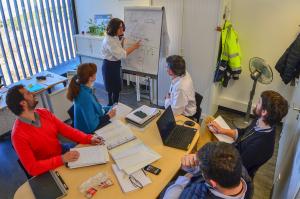"It's a pragmatic, graduated approach," says Joëlle Elbez-Uzan, who was part of the early 2000 European ITER Site Studies (EISS) and who now heads the ITER Environmental Protection & Nuclear Safety Division. "The French regulations define the objectives, and let the nuclear operator propose the means to meet these objectives. Solutions have to be proportional to what is a stake in terms of safety. It's a creative and adaptive process ..."
"Oversizing" protection is an obvious option when seeking to mitigate risks. But oversizing has consequences not only in terms of cost but also in terms of robustness. "The more massive a protective measure gets, the more complex and the less robust it becomes. By applying a 'just required' approach we minimize costs and achieve better robustness," adds Joëlle.
Such a philosophy is well adapted to a fusion installation whose potential risks cannot be compared to those of a fission installation.
Joëlle remembers that when she moved from fission to fusion the first thing that struck her was the fundamental difference in physics. "What happens in the core of a fusion reactor is intrinsically safe—if parameters cease to be nominal, the reaction simply stops. And of course this is something we had to take advantage of."
Whereas a fission reactor contains more than one hundred tonnes of solid fuel (enriched uranium of mixed uranium-plutonium oxide), there is never more than a few grams of gaseous fuel in the ITER vacuum vessel at any given time. As a direct consequence, the stored energy is minimal.
This and other fusion-specific characteristics have led safety experts to rely as much as possible on "passive solutions" for ITER. The cooling water system is not classified as a "safety function" in a fusion reactor, for instance. It comprises a single loop only, whereas in a fission reactor a second loop must be able to take over from the first in an emergency situation.
Although some of the safety parameters for the ITER design were established by extrapolating from the fission world, safety analysts were confronted with a number of never-before-encountered situations.
Because of its operational needs, ITER will have to manage significant quantities of tritium—a situation Joëlle describes as "completely new for a nuclear installation."
In dealing with tritium [
see box], the "lessons learned" approach proved essential. Feedback from CANDU reactors, the Karlsruhe Tritium Laboratory and even the JET (European) and TFTR (US) tokamaks, which handled minute quantities of tritium during
experiments in the 1990s, provided a basis to develop R&D tritium handling programs up to prototype scale.
The vacuum vessel also raised specific safety issues, as there was no readily available code applicable to this unique component and the stresses/forces it will be subjected to. Codes applying to fission reactor vessels were adapted to the specific geometry of the ITER vessel and to the conditions it will face (for instance the impact and subsequent irradiation of the inner walls by energetic neutrons, or unique stresses and movements—such as vertical displacement events).
"ITER operation and its progressive ramp-up will provide a unique opportunity to confirm our hypotheses, validate the safety methodology and refine the regulatory framework and international guidelines for fusion installations," says Joëlle.
For decades, nuclear safety was not central to fusion research, as only two experiments—and only very briefly—had ever employed nuclear fuel in fusion operations.
Now, with ITER, everything has changed. "Ensuring the safety of an installation goes way beyond establishing codes and procedures," says Joëlle. "It is about embedding a 'safety attitude' into each and every action we take. What is at stake here is nothing less than the project's success."


